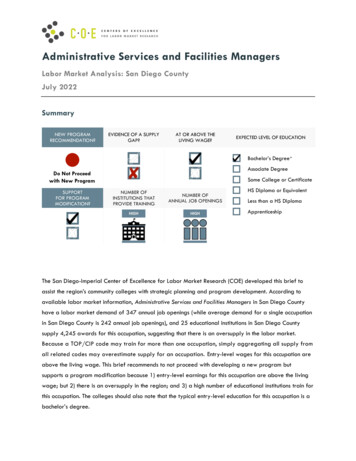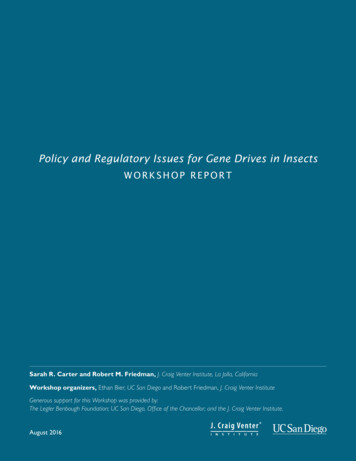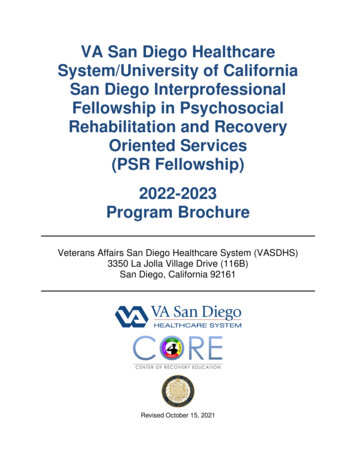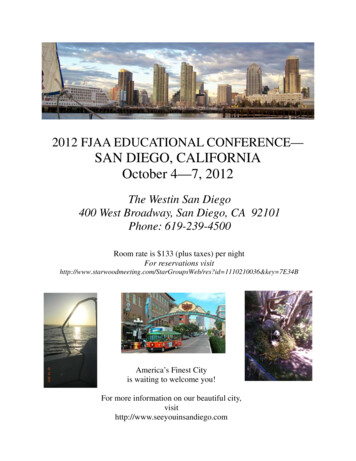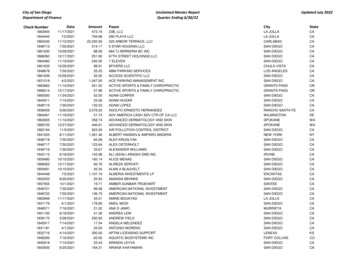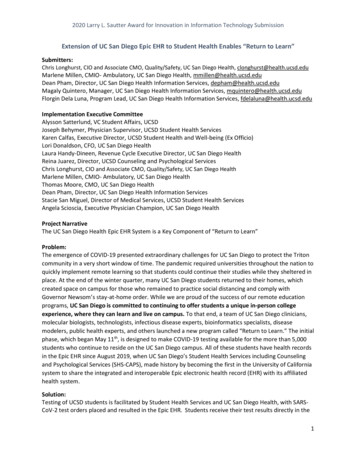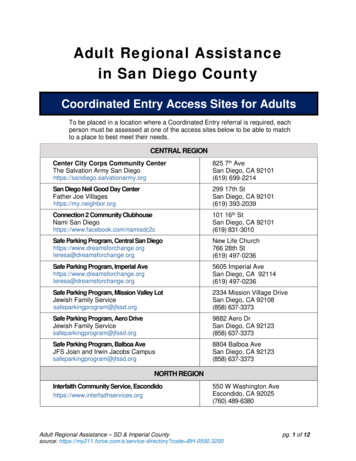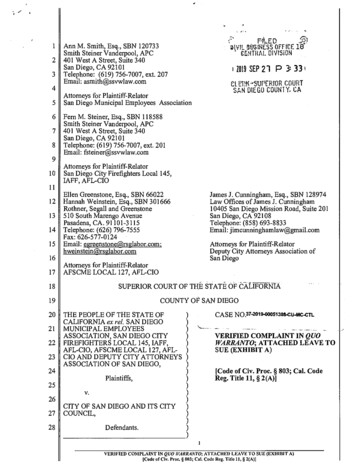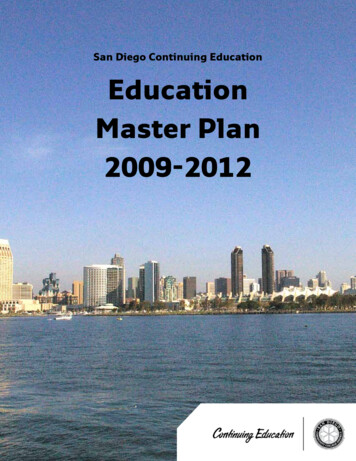
Transcription
San Diego Continuing EducationEducationMaster Plan2009-2012San Diego Continuing Education2009 - 2012 Master Plan1
San Diego Continuing EducationEducationMaster Plan2009-2012San Diego Continuing Education2009 - 2012 Master Plan2
Board of TrusteesMary Graham, Rich GroschBill Schwandt, Maria Nieto Senour, Ph.D., Peter ZschiescheConstance M. Carroll, Ph.D.ChancellorSan Diego Community College DistrictAnthony E. Beebe Ed.D.PresidentSan Diego Continuing EducationSan Diego Continuing Education is accredited by the Accrediting Commission for Community and JuniorColleges of the Western Association of Schools and Colleges, 10 Commercial Blvd., Ste. 204, Novato, CA94949, 415-506-0234, an institutional accrediting body recognized by the Council for Higher EducationAccreditation and the U.S. Department of Education.San Diego Continuing Education2009 - 2012 Master Plan3
What is San Diego Continuing Education?Basic Skills GED - High School DiplomaA sequence of courses to provide instructionfor individuals in elementary (to 8th grade) andsecondary-level (high school) reading, writing,computation, and problem-solving skills inorder to assist them in achieving their academic,vocational, and personal goals.CitizenshipProvides immigrants and their families with theopportunity to become active and participatingmembers of economic and civic society, and mayinclude preparation for citizenship.Community EducationThe Mission of the Community EducationProgram is to provide diverse, affordablepersonal and professional enrichment workshopsto the San Diego community. CommunityEducation classes are offered for a fee, based onthe number of hours the class meets.Disabilities SupportPrograms and ServicesProvides individuals with disabilities life-skillproficiencies that are essential to the fulfillmentof academic, vocational, and personal goals.Emeritus ProgramLifelong education that provides opportunitiesfor personal growth and development,community involvement, skills for mentaland physical well-being, and economic selfsufficiency for older adults.San Diego Continuing Education2009 - 2012 Master PlanEnglish as a Second LanguageProvides instruction in English language toadult, non-native English speakers with variedacademic, vocational, and personal goals.Primarily in, but not limited to, areas of listening,speaking, reading and writing, and may integrateother areas such as computer literacy, culturalcompetency, study skills, and life skills.Family & Consumer SciencesOffers lifelong education to enhance the qualityof home, family, career and community life.Provides opportunities that respond to humanneeds in preparing individuals for employment,advanced study, consumer decision-making andlifelong learning.Health & Safety EducationPromotes the health, safety and well-being ofindividuals, families, and communities.Parent EducationProvides lifelong education in parenting, childdevelopment and family relations in order toenhance the quality of home, family, career andcommunity life.Career Technical EducationShort-term vocational programs with highemployment potential. Sequential courseslead to a vocational/career technical objective,certificate or award that is directly related toemployment.4
TABLE OF CONTENTSPreface.7The Planning Process.7Noting the Trends.7Providing the Planning Environment.8Continuing Education Vision, Philosophy and Mission.8Population Trends. 10Population Trend Implications for Continuing Education. 11Economic Trends. 11Economic Trend Implications for Continuing Education. 11Educational Trends and English Proficiency. 12Educational Trend Implications for Continuing Education. 13Designing the Objectives. 131.0Adult Basic Education. 152.0Adult Secondary Education. 203.0English As A Second Language. 244.0Career Technical Education. 295.0Business Information Technology. 326.0Emeritus Program. 357.0Parent Education. 388.0Hospitality and Consumer Services. 429.0Allied Health Programs. 4510.0 Disability Support Programs and Services (DSPS). 4911.0 Community Education. 5512.0 Contract Training & Workforce Certification. 6013.0 CalWORKs. 6214.0 Student Services. 6515.0 Career Development Services. 6816.0 Continuing Education Campuses. 6917.0 Continuing Education Facilities. 70San Diego Continuing Education2009 - 2012 Master Plan5
SAN DIEGO CONTINUING EDUCATIONEDUCATION MASTER PLAN COUNCILAnthony Beebe, Ed. D.Brian Ellison, Ed. D.Robert ParkerRay RamirezPresident, San Diego Continuing EducationVice President, Instruction and Student ServicesVice President, Administrative ServicesDean of Institutional EffectivenessSy Lyon, DeanGary GleckmanAlma McGee, DeanGretchen Bitterlin, ChairpersonJane Signaigo-Cox, DeanBill Borinski, ChairpersonJim Vincent, DeanJoe McGerald ChairpersonLeslie Shimasaki, DeanKim McIntyre, ChairpersonLeslie Shimasaki, DeanRoma Weaver, ChairpersonSy Lyon, DeanDonna Namdar, ChairpersonRobin Carvajal, DeanKenneth Parker, ChairpersonAnne Heller, DeanMarie Doermer, ChairpersonRobin Carvajal, DeanJane Signaigo-Cox, DeanLorie Howell, Ph.D., DeanMarcia Biller, DeanDoug Elliot, FacultyRanessa Ashton, SupervisorLorie Howell, Ph.D., DeanEsther Matthew, FacultyRita Avila, ClassifiedAdult Basic Education andAdult Secondary EducationEnglish as a Second LanguageSan Diego Continuing Education2009 - 2012 Master PlanCareer Technical EducationBusiness Information TechnologyEmeritus ProgramParent EducationHospitality and Consumer SciencesAllied Health ProgramsDisability Support Programs and Services/Student AffairsCommunity EducationContract Training & Workforce CertificationCalWORKsStudent ServicesCareer Development ServicesCommunication ServicesSpecial Population and Professional DevelopmentAcademic SenateClassified Senate6
San Diego CONTINUING EDUCATIONEducation MASTER PLANPrefaceAn education master plan sets the tone and direction of an institution’s efforts over amultiple year time frame. A master plan, in order to be effective, must have within it amechanism for evaluation of the planning process. The implementation process mustinclude a periodic assessment of its goals, objectives and actions to measure progress.Evaluation and redirection are the most essential components of the full planningprocess and key ingredients in preserving the viability of an effective education masterplan.With these considerations in mind, the present master planning process has beenorganized to include committee structures, which will ensure not only its viability butits power to inspire and to guide genuine growth and accomplishment in ContinuingEducation. Monitoring committees dedicated to overseeing the plan’s essentialcomponents: planning, implementation, evaluation and redirection have been formedand their charge is to oversee the education master plan’s implementation.The committees include representatives from Continuing Education’s SharedGovernance Councils:»»»»Executive Governance Council (EGC)Administrative Governance Council (AGC)Academic SenateClassified SenateTHE PLANNING PROCESSPrior to the multiple committee approach to monitor activity supported by theEducation Master Plan, a Master Plan Council was created and charged with thisresponsibility. The original Education Master Plan was created in 1990 and revisedby this council in 2005-2006. Subsequent revisions occurred in 2007-2009 and wereoverseen by the shared governance committees cited above.NOTING THE TRENDSThe charge to the 1999 Master Plan Council was to determine the present andimmediate future needs of San Diego’s urban population, to note the prevailingtrends surrounding those needs and the implications those trends have for ContinuingEducation. The 2006 Committee sought to update and revise those needs based onnew expanded and relevant information gathered via the District’s 2005 environmentalscan “San Diego Regional Environmental Scan” by JCF Consulting.San Diego Continuing Education2009 - 2012 Master Plan7
The new revisions of 2008 and 2009 reflect the reorganization plan dated July, 2007that shifted the focus of Continuing Education from a site-based administration to aprogram anchored on the precepts outlined in the document The Cornerstones of ourFuture, a strategic plan for Continuing Education. (A. Beebe, 2007).PROVIDING THE PLANNING ENVIRONMENTSan Diego Continuing Education’s original Education Master Plan was written in 1990and has been revised periodically to reflect changes in the environment that representsSDCE’s service area. Master Plan Council members participate in sessions to reviewthe current social, demographic, economic and educational trends and try to predictfuture trends through its strategic planning process. From this output, the goals andobjectives and implementing plans are developed. Representative committees formatthe goals and objectives, and determine the appropriate implementation plans withpriorities identified. This process originated in January 1999 and involved over 300personnel including faculty, classified, and administration.In 1990, the directives of both the president of Continuing Education and theChancellor of the San Diego Community College District were to establish a“pro-active process to plan for current realities, and to the extent possible, identifyfuture trends.” The master plan council identified needs, planned responses to thoseneeds and established or changed the curriculum. This dialogue included the need formore adequate facilities to serve students in a manner that was appropriate and inkeeping with identified priorities, thus providing for the community viable and excellentprograms of study that fulfilled San Diego Continuing Education goals.The subsequent SDCE Education Master Plan revisions in 1999, 2006, 2008, and 2009,enhanced this process reflecting service area changes and the institutions collectiveresponse to the changing environment.VISION STATEMENTSan Diego Continuing Education will be the state’s leading noncredit educationalprovider, based on quality of services offered and variety of courses available, assistingstudents to transform their lives.PHILOSOPHY STATEMENTSan Diego Continuing Education is a multicultural institution dedicated to providingeducational access and lifelong learning opportunities. Our commitment is to allstudents who come through our doors, without regard to their academic skill or life’schallenges, offering innovative, high quality instruction and student support services.We believe that people have the capacity to change and that education can positivelytransform individuals, enriching their lives and contributing to our community.San Diego Continuing Education2009 - 2012 Master Plan8
CORE VALUESWe, the Continuing Education faculty, staff, and administration of San DiegoCommunity College District, acknowledge our responsibility to society and believe thataccess to lifelong learning is a cornerstone of a democratic society. We consider it ourduty to anticipate changing demands in education and welcome the opportunity toshape the future. We place students at the center of all that we do, supporting andpromoting excellence in their endeavors. We affirm and embody pluralism; we valuecollaboration and shared decision-making; and we honor creativity and innovation.MISSION STATEMENT(abstracted)To provide ongoing learning opportunities, preparing diverse individuals for careeradvancement, a college education, or enriched lives through good health and personalfulfillment.MISSION STATEMENT(comprehensive)San Diego Continuing Education has roots dating to 1914. It is one of the largestseparately accredited noncredit programs in the nation, offering no and low costclasses throughout San Diego. Continuing Education seeks to integrate lifelonglearning into all San Diegan’s lives, as evidenced by growing enrollments. ContinuingEducation students come with varied educational goals, including career advancement,college preparation, and life enrichment. To serve these student goals, we recruitdiverse faculty with extensive experience and education, including professionalcertifications, Master’s, and/or Doctorate degrees. Faculty professional developmentto maintain subject area expertise is critical to our success. Continuing Educationstrives to diversify its course offerings, creating a vast array of lifelong learningopportunities. Continuing Education’s programs and courses relate to the following:»»»»»»»»»Basic skills courses for those needing basic reading, writing, and math skillsEnglish as a Second Language (ESL) courses for limited English speakersHigh school completion and GED preparation courses for those not completinghigh schoolOlder adult courses supporting and promoting positive agingDisability Support Programs and Services courses for persons with disabilitiesParent Education courses to increase parenting skillsCommunity Education courses providing fee-based professional and personalenrichment classesContract Education courses customized to the specific needs of businessand industryCareer Development and College Preparation (CDCP) courses.Continuing Education functions as an integral part of the San Diego CommunityCollege District, providing transitional pathways to the three credit institutions: CitySan Diego Continuing Education2009 - 2012 Master Plan9
College, Mesa College, and Miramar College. Continuing Education’s six campuses andmore than 300 community locations are important to our community presence andimage/identity. Campuses are staffed by professional and competent classified andadministrative personnel, who strive to serve the best interests of students. ContinuingEducation’s vision, philosophy, values, and mission is founded on hiring qualifiedpersons without regard to age, gender, disability, ethnicity, religion, or national origin.POPULATION TRENDSSan Diego’s population has been growing and changing, indeed, in the year 2000, itbecame a “minority majority” city with no ethnic group constituting over 50 percentof the population. In 1987 San Diego took its place among the nation’s cities withpopulations of one million or more. This milestone, achieved with some celebration,played a part in San Diego’s discovery by people across the nation. Its population hasbeen expanding since with an average annual increase of 1.1 percent each year.San Diego’s population is becoming more noticeably stratified, with a large numberof the entire population living at or below the poverty level. People who are unable tomatch their personal skills with the opportunities that life presents in this city or whohave personal addictions that are not successfully treated, are finding their homesin the streets in ever increasing numbers. The homeless are becoming a dramaticstatement on San Diego’s landscape.Groups from every ethnic background are finding a new home for themselves inSan Diego. In 1990 the non-Hispanic White residents comprised 65 percent of thepopulation. Hispanics accounted for 20 percent of the population while AfricanAmericans made up 6 percent and Asians and others 8 percent. By 2015 the nonHispanic White population will decrease to 51 percent, while the Hispanic populationwill increase to 32 percent and Asians and Others will increase to 11 percent. TheAfrican Americans population will remain constant, comprising 6 percent of theregions’ population. By 2030 the population will include 36 percent White,34 percent Hispanic with Asian Pacific Inlanders showing a slight increase andthe African Americans population will decline slightly as a percent of the total(see figure #1)Project stribution20302030Another noteworthy development asSan Diego continues to grow is that6545-6419%0-9it attracts great numbers of older22%11%adults drawn by our mild climate and10-1725-448%18-24Southern California’s reputation as a29%11%health conscious center. And, as the“baby boom” generation moves towardretirement age, over 25 percent of ourpopulation will be age 55 or older by2015. This represents an increase from Figure 1/Source SANDAG17 percent in 1990. By 2030 only 60percent of the population will be in the 18-65 working age range and there will be asmany persons over 65 as there will be children under 18.San Diego Continuing Education2009 - 2012 Master Plan10
POPULATION TREND IMPLICATIONS FORCONTINUING EDUCATION»»»Continuing Education will need to prepare to assess and remediatenon-literate and semi-literate persons as they enter our region. There willbe an increased need for vocational training and preparatory courses in basicskills, ESL and vocational ESL (VESL) as well as bilingual assistance in vocationaland business information technology coursesAs more and more employers require a corps of highly educated potentialemployees, workplace literacy programs will become area of focus bothas public service classes and contract classes for business and industryAdditionally, programs designed to meet the needs of the ever increasing olderadult population must be designed to the requirements and the sheer size ofthis populationECONOMIC TRENDSFor the past 50 years, much of our manufacturing employment base was relatedto defense industry expenditures. Military payroll jobs and jobs supporting militaryprocurement contracts brought billions of dollars into the region. With the downsizingof the military in the early 1990’s, employment fell dramatically. After relyingon federal defense dollars for over half a century, the loss of so many high payingmanufacturing jobs in the early to mid 1990s, and the duration of the recession, wasthe worst San Diego has experienced since record keeping began in the 1950’s. Theforecast indicates an increase of an average of 14, 000 new jobs annually between1990 and 2015. However, the composition of the jobs created during these 25years will be different that those created in the last 25 years. These changes willconsiderable affect the type of employment opportunities the region has to offer. Outof all the jobs created through 2015, only about 10 percent will be in the high payingsectors such as Construction, Manufacturing and Transportation, Communicationand Unities; while 60 percent will be in the lower paying sectors such as the Servicesand Wholesale/Retail trade sectors. Government jobs will make up nearly 12 percentof the growth. Seven percent of the growth will be in the finance, insurance and realestate fields, with the remaining employment being created in other sectors. By 2030SANDAG projects that business, personnel, health, entertainment and social serviceswill continue to drive the region’s economy.ECONOMIC TREND IMPLICATIONSFOR CONTINUING EDUCATIONIn the past, Continuing Education has offered entry-level courses in various disciplinesand it will be appropriate to offer more short-term, intermediate and advanced levelcourses to permit continuing students to upgrade their job performance skills at theirworksites, at the campuses or in the local community.San Diego Continuing Education2009 - 2012 Master Plan11
All vocational curricula need to incorporate SCANS (Secretary’s Commission onAchieving Necessary Skills, U.S. Department of Labor) goals that include criticalthinking, organization and interpersonal relationship skills; in addition to the basicskills of speaking, listening, reading and writing.As older adults return to the work force, special courses must be designed to utilizetheir experiences and talents, while possibly training them for new job requirements.The issue of child care will need to be considered to accommodate large numbers ofnew students seeking training, particularly under California Welfare Reform and otherstate and federal mandates.EDUCATIONAL TRENDS AND ENGLISH PROFICIENCYAs the demographic pattern in San Diego shiftsto include more persons from a variety of foreignethnic backgrounds, there will be more limitedEnglish Proficiency Speakers (LEP).Language Spoken at HomeCity of San Diego 200062% English Only16% English & SpThe U.S. census informs that 91 percent of thelanguages spoken at home in 2000 in the city ofSpoken at HomeSan Diego include English or English andLanguageanotherCity of San Diego 2000language. Only 6 percent spoke Spanish onlyFigure 2/Source SANDAGand 3 percent spoke another language only.(See figure 2) High School graduates seekingskills training or high school dropouts are likely to take advantageof Continuing Education’s educational programs. LEP’s,particularly from the Hispanic/Latino community, comprise asignificant percentage of the enrollment in Continuing Education’sEnglish as a Second Language program.13% Other Langu6% Spanish Only3% Other Langua62% English Only16% English & Spanish13% Other Languages & English6% Spanish Only3% Other Language OnlyFigure 2/Source SANDAGEducational attainment by ethnicity is also significant. Students from all ethnicbackgrounds are dropping out of high school at higher rates.Residents, as well as new immigrants, can be prepared for full participation inAmerican life through the efforts of Continuing Education. Another significant trendis that as more women are entering the work force they are attending ContinuingEducation classes, acquiring basic skills and job training in increasing numbers. Inaddition, welfare reform, called CalWORKs in California, has placed a five year lifetimelimit on welfare subsidy. All persons currently receiving welfare benefits are mandatedto develop a plan for entering employment. Many of these men and women will enrollin Continuing Education classes for vocational training to meet this mandate.San Diego Continuing Education2009 - 2012 Master Plan12
EDUCATIONAL TREND IMPLICATIONSFor CONTINUING EDUCATIONThe expansion of diversity among students and stakeholders in SDCE requires agreater degree of cross-cultural sensitivity among its faculty staff and students. Thecurriculum must be periodically updated to make it more contextual and responsive tothis diverse student body. In this context, SDCE needs to increase its efforts in studentassessment of prior preparation through pre and post testing especially in careertechnical courses and programs.The high drop-out rate among certain high school students is of great concern tosociety in general and to SDCE in particular. This concern must result in efforts toameliorate this problem among our youthful populations through creative outreach tohigh-risk students with linkages developed with high school counselors, communitybased organizations, and the students themselves. A strong orientation program forstudents is essential to any subsequent growth and ultimate success for this cohort.SDCE designs and implements effective retention and learner persistence strategiesas well as state-of-the-art programs that address the needs of students. “Smart”classrooms with computers and internet access more often than not are the norm forSDCE. Additionally, we need to expand effective online courses which meet the needs ofthe community we serve. San Diego Continuing Education provides relevant educationopportunities for its students.Currently, classes for students with disabilities are scheduled in convenient andaccessible locations. As our knowledge of the population of students with disabilitiesgrows, we need to develop more relevant curricula to successfully meet theireducational requirements.In summary, the goal of San Diego Continuing Education is to provide non-credit andcareer technical courses and programs for all the communities we serve.DESIGNING THE PROGRAM OBJECTIVESThe Master Plan Council considers promoting excellence in all Continuing Educationprograms of paramount importance and has established the following priorities whichare related to all subject area disciplines:»»»»»»»Student Learning Outcomes (SLO’s) must be documentedCurricula should be current and relevantCritical thinking and problem-solving skills should be taught in every classMore short-term courses should be offeredCurrent information on health issues (including substance abuse) should beprovided to both students and staffOrientation for new students should be provided at every siteOrientation should be provided for all new faculty and classified employeesSan Diego Continuing Education2009 - 2012 Master Plan13
The revision occurring during 2008-2009 incorporated the strategic plan and the fourcorner stones into the architecture of this document. The programs and services belowfocused all goals and objectives toward the four cornerstone statements in order tostrengthen the relationship between the Education Master Plan and the Strategic Plan.»»»»»»»»»»»»»»»»»Adult Basic Education (ABE)Adult Secondary Education (ASE)English as a Second Language (ESL)Career Technical Education (CTE)Business Information Technology (BIT)Emeritus ProgramParent EducationHospitality and Consumer ServicesAllied Health ProgramsDisability Support Programs and Services (DSP&S)Community EducationContract Training and Workforce CertificationCalWORKs ServicesStudent ServicesCareer Development ServicesContinuing Education CampusesContinuing Education Facilities and Proposition Projects ReportsSan Diego Continuing Education2009 - 2012 Master Plan14
1.0 Adult Basic Education (ABE)Goals and Objectives1. Purpose/Vision:To offer flexible, accessible, up-to-date programs for adult seeking basic literacy inreading and mathematics, completion of high school, GED, competency in the Englishlanguage, citizenship, vocational skills or enrichment.2. Goals:Goal A – Increase Professional DevelopmentBuild a multi-departmental instructional team to develop an integrated model ofbasic skills across the curriculum.Objective 1:Participate in Basic Skills Initiative, Phase III staff development activitiesoffered by the CCCSO.Sub-Objectives:q Send teams of managers and faculty to the series of trainingopportunities provided in Phase III of the California Basic SkillsInitiative including:n statewide conferencen regional meetingsn Workshops to “order” and assist with action planimplementation strategiesq Share implementation strategies with all BSI facultyq Incorporate training ideas into the delivery plan for BSI studentsObjective 2:Plan and provide research-based staff development for interdisciplinaryteams relevant to the goals and objectives of the Action Plan.Sub-Objectives:qqProvide orientation and a series of trainings on the underlyingresearch for the Basic Skills InitiativeAccording to need, provide staff development to BSI faculty ondirect instruction, managed enrollment, working collaborativelywith student servicesGoal B – Expand Course DiversityProvide a learning environment that promotes student retention and persistenceand increased transfer to the San Diego Community College District by providingContinuing Education students with expanded instructional options to attain theireducational goals.San Diego Continuing Education2009 - 2012 Master Plan15
Objective 1:Expand the BSI Phase II model projects to additional sites.Sub-Objectives:q Expand the BSI Steering Committee to be representativeof all basic skills disciplines, as well as student servicesn Meet monthly to keep lines of communication open amongthe basic skills disciplines involved in the basic skillsinitiativen Report monthly to the Academic Senate and the ExecutiveGoverning Council as to successes and challenges inimplementing the Action Planq Evaluate data from Phase II model projects to guide revision anddevelopment of additional “Student Success Centers”q Replicate the model Student Success Centers at additional sitesn Offer ABE/ESL/ASE students an option for small groupinstructio
San Diego Continuing Education 2009 - 2012 Master Plan 3 Board of Trustees Mary Graham, Rich Grosch Bill Schwandt, Maria Nieto Senour, Ph.D., Peter Zschiesche Constance M. Carroll, Ph.D. Chancellor San Diego Community College District Anthony E. Beebe Ed.D. President San Diego Continuing Education

